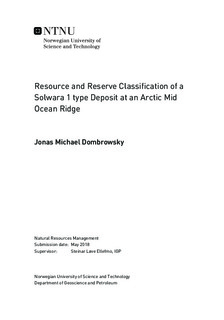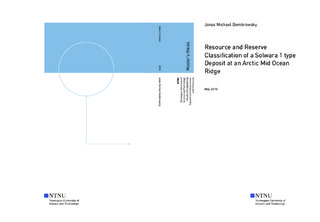| dc.contributor.advisor | Ellefmo, Steinar Løve | |
| dc.contributor.author | Dombrowsky, Jonas Michael | |
| dc.date.accessioned | 2018-08-16T14:00:57Z | |
| dc.date.available | 2018-08-16T14:00:57Z | |
| dc.date.created | 2018-05-15 | |
| dc.date.issued | 2018 | |
| dc.identifier | ntnudaim:16321 | |
| dc.identifier.uri | http://hdl.handle.net/11250/2558332 | |
| dc.description.abstract | As land based deposits become depleted, deep sea deposits with a high concentration of eco-nomic elements become a new focus for exploitation. Comparing deep sea mining activities with their land based counterparts can help to understand and prevent problems in deep sea mining. A 3D geometric model based on the data for the Solwara 1 deposit, a seafloor mas-sive sulfide deposit in the Bismarck Sea, has been created using the modeling software Leap-frog Geo. This model has been further refined and qualimetric constraints put on it to check its economic viability. With a cut off grade of 2.6% the resource estimate resulted in 834 kt indicated and 1299 kt inferred ore with an average copper equiva-lent grade of 7%. Since the resource estimate has only indicated and inferred ore the reserve can only be classified as probable. Depending on the mining system used this results in 417 kt to 584 kt probable ore reserve. It is also largely unknown what environmental effects deep sea mining has. Further research of the Solwara 1 deposit to increase geological knowledge and the effects of deep sea mining on the environment must be taken before mining activities should begin. | |
| dc.language | eng | |
| dc.publisher | NTNU | |
| dc.subject | Natural Resources Management, Ressursgeologi | |
| dc.title | Resource and Reserve Classification of a Solwara 1 type Deposit at an Arctic Mid Ocean Ridge | |
| dc.type | Master thesis | |

